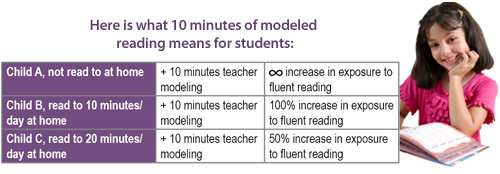Many students enter our classrooms with limited vocabulary and loads of catching up to do. I’ve seen teachers discouraged by the challenge they are faced with, and yet doing valuable things in their classrooms everyday to not only meet challenges but to exceed expectations. The good news is that the little things we do everyday can have a great impact.
Why Modeled Reading Matters
“Children are made readers on the laps of their parents.” - Emilie Buchwald
Our students have a wide range of lap hours logged. For some, the idea of climbing up to listen as someone reads to them is more natural than putting on a pair of socks, while for others it’s a rare event. In classrooms, allchildren benefit from listening as we read.
Modeling fluent reading in our classrooms and displaying our love for the written word benefits every student, but it is essential for those students who do not get this benefit at home.

Older students can benefit as well. On this topic, Jim Trelease, author of The Read-Aloud Handbook,says, “Every read-aloud is an advertisement for pleasure, every worksheet is an ad for pain. If the pain outweighs the pleasure, the customers go elsewhere.” When we read and showcase our love of reading we are advertising the very thing we want our students to buy.
Get Students Reading More, More, More (and More)
“There is ample evidence that one of the major differences between poor and good readers is the difference in the quantity of total time they spend reading.” - National Reading Panel, 2000
The best way to improve reading skill is through reading practice. If we’ve modeled fluent reading for students and chosen material that is a great fit for their ability and their interest, then we have set the stage for practice.
It’s no wonder that good readers read a lot and poor readers read little. If an activity is not pleasurable, devoting time to it is not desirable. However, as good readers read and poor readers do not, the gap in their ability grows. We must encourage all of our students to read. We must find ways to make reading pleasurable for all students.

*Note that I’ve indicated Children A, B & C are all reading at the same rate (100WPM). Though this scenario may be unlikely, it highlights the gains that are possible for all students. As their reading improves, their rate will increase along with more words devoured.
For those with poor skills, the need to practice is critical—not only to improve their reading ability, but also to open their world. These “words” represent new vocabulary, new ideas, new topics, and new learning. By getting students to read more we are expanding their imaginations and building their background. When students read little they miss out on so much more than slow-growing reading skills.
A Deep and Continuing Need
One final note on quality. To incent students to read and to help them read well, we must also focus on motivation and help students choose reading material that will be inspiring and well suited to them.
“Any book that helps a child to form a habit of reading, to make reading one of his deep and continuing needs, is good for him. ” - Maya Angelou
I’ve always been struck by some of the reading material we put in front of our struggling readers. As I’ve worked with students on their assigned texts, I can’t help but find myself bored and listless. How can we expect students to develop a fondness for reading if what we’re asking them to read is not particularly good? Think about why you read and what you like to read. I’ve yet to find the well-read adult who chooses reading material based on their ability level alone. Instead, they read to gather information, to soak up a genre they are especially fond of, to escape and to dream. To foster this ‘deep and continuing need’, we need to provide our students with delicious, fantastic literature. They need rich vocabulary, exotic stories and variety. At times this beautiful content is beyond the reach of our students’ ability, but we are wise to help them reach, to scaffold, to encourage and to make every attempt to give them the good stuff.
“It is not enough to simply teach children to read; we have to give them something worth reading. Something that will stretch their imaginations—something that will help them make sense of their own lives and encourage them to reach out toward people whose lives are quite different from their own.” - Katherine Patterson
Related reading:
Building Fluent Readers: How Oral Reading Practice Helps Reading Comprehension
After Just 24 Days, Summer School Students Significantly Improve Reading Scores

